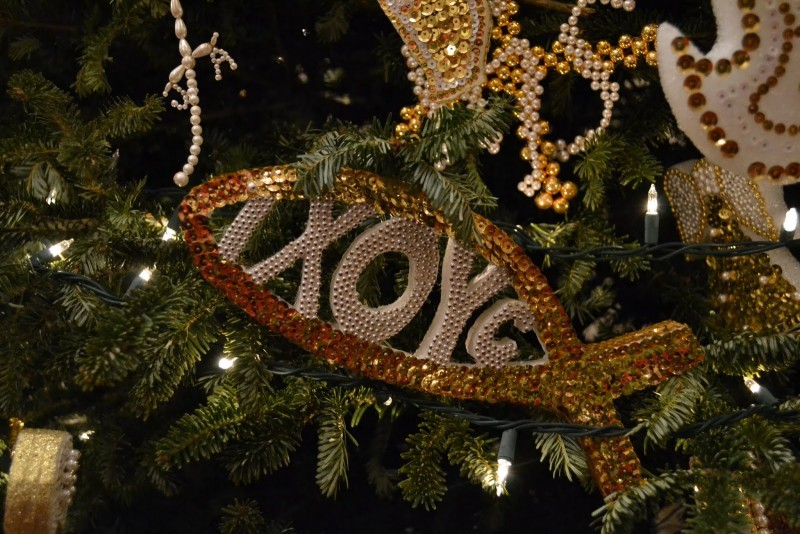| December 1, 2016
THE CHRISMON TREE
The Chrismon Tree originated in 1957 at the Ascension Lutheran Church in Danville, Virginia.[1] From a one-time, volunteer-made Christmas tree in a small church, the Chrismon tree has become a world-wide practice of proclaiming and celebrating God’s promises, God’s saving work, and God’s faithfulness to all generations. Chrismons are utilized in worship, educational, and social activities most often seen during the Christian celebrations of Christmas and Easter.
Chrismons are named by combining the words Christ + Monograms, thus the symbols became known as Chrismons. The "Monogram of Christ" is the term first applied to an inscription of the first two letters of the Greek word for Christ (XP). According to church tradition, this symbol first appeared around 268 CE.[2] From this ancient symbol came the idea for the Christ monograms (Christ symbols) we see in churches today.
Chrismon ornaments call for working with one’s own hands in keeping with the spirit of the original volunteer who made the ornaments as an act of personal meditation on the person of Christ. One does not merely buy the ornament but rather makes the ornaments according to his or her own abilities, local supplies, and the particular needs of a congregation. While working, the artist is encouraged to offer a simple breath prayer. The goal of the work is not just a pretty Christmas decoration, but rather to have a deeper understanding of the question, “Who are you, Lord?” at the end of the process.
The evergreen tree, symbolizing abundant and eternal life, is the background for the white and gold Chrismons. The colors of gold and white relate to glory, light, and celebration. Christ who is the light of the World left glory to invite us into the life of the Triune God. Celebration days in the Christian church are marked by the colors of white and gold.
Some Chrismons are copies of symbols of Christianity from its earliest days: The Fish, one of the oldest Christian symbols, incorporates the letters from the Greek word for fish (ichthus), and stands for Jesus (I), Christ (X), God (Q), Son (Y), Savior (S). Some of Jesus' disciples were fishermen and used this sign to identify as followers of Jesus. The Star of David is a symbol reminding followers that Jesus was a Jew and a descendant of King David. The Nativity Star or Comet Star is the symbol of the Star of Bethlehem or Epiphany, which led the Magi to Jesus – a sign that even the cosmos recognized the God of all who became Incarnate among his own creation. The Shepherd's Staff reminds that Jesus called himself a shepherd, a Good Shepherd, for all people.
Other Chrismons are newer symbols of God's never-changing presence in our ever-changing world: An Anchor Cross reminds Christians that Jesus is the anchor of their faith, An Eight Pointed Star represents new life and regeneration in God’s kingdom, A fleur-de-lis or three-leaf clover symbolize the Trinitarian relationship of God who invites humanity to participate in divine life, and A Crown symbolizes that Jesus is ruler over heaven and the earth. [3]
It is an important task we have to pull our children back from the consumer-driven, overscheduled, hype that has become the American experience of Christmas. It is even more pressing to share with them the stories of our faith.
As we await the celebration of the Incarnation of a holy God bound in the frailty of a messy human birth, making Chrismons together is a good way to learn more about the One who is the Great Light in the darkness (Isaiah 9:2; John 8:12). What a wonderful way to share about the One whose birth we celebrate in the season of Christmas (Luke 2). What a way for us to wonder about the One for whom we continue to wait (Revelation 21:23; 22:5).
What symbols would speak to you? To your children? This year, spend some time learning about Chismons -and while you’re at it, perhaps your family can share what Christ means to each of you by making your own unique Chrismon design.
The Chrismons on our tree were made by children in our church in 2012.
~SMHJ
[1] “Chrismons and Chrismon patterns” http://www.whychristmas.com/customs/chrismons.shtml
[2] Catholic Encyclopedia. “Monograms of Jesus Christ” http://www.newadvent.org/cathen/10488a.htm
[3] “Chrismons and Chrismon patterns” http://www.whychristmas.com/customs/chrismons.shtml and see also “Christian Symbols Christmas Ornaments” http://www.crivoice.org/symbols/ornaments.html
Comments
As a Baptist church affirming the liberty of conscience, we recognize each individual's right to his or her own opinion and welcome your comments, positive or negative. We strive for communication that invites a respectful and personal exchange of opinions and thoughts. This is often not possible through running dialogues in our comment section. To respect the dignity of all persons, we may delete comments that contain profanity, hate speech, or threatening language.
There are no comments



